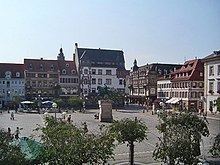District Urban district Time zone CET/CEST (UTC+1/+2) Population 43,008 (31 Dec 2008) | Elevation 142 m (466 ft) Postal codes 76829 | |
 | ||
Weather 5°C, Wind NE at 14 km/h, 72% Humidity University University of Koblenz and Landau Points of interest Landau Zoo, Reptilium Terrarien‑ und Wüst, Palatinate Forest, Geißkopf, Striefflerhaus | ||
Landau, or Landau in der Pfalz, is an autonomous (kreisfrei) town surrounded by the Südliche Weinstraße ("Southern Wine Route") district of southern Rhineland-Palatinate, Germany. It is a university town (since 1990), a long-standing cultural centre, and a market and shopping town, surrounded by vineyards and wine-growing villages of the Palatinate wine region. Landau lies east of the Palatinate forest, Europe's largest contiguous forest, on the German Wine Route.
Contents
Map of Landau, Germany
It contains the districts (Stadtteile) of Arzheim, Dammheim, Godramstein, Mörlheim, Mörzheim, Nussdorf, Queichheim, and Wollmesheim.
History
Landau was first mentioned as a settlement in 1106. It was in the possession of the counts of Leiningen-Dagsburg-Landeck, whose arms, differenced by an escutcheon of the Imperial eagle, served as the arms of Landau until 1955 [1]. The town was granted a charter in 1274 by King Rudolf I of Germany, who declared the town a Free Imperial Town in 1291; nevertheless Prince-Bishop Emich of Speyer, a major landowner in the district, seized the town in 1324. The town did not regain its ancient rights until 1511 from Maximilian I. An Augustinian monastery was founded in 1276.
Landau was later part of France from 1680 to 1815, during which it was one of the Décapole, the ten free cities of Alsace, and received its modern fortifications by Louis XIV's military architect Vauban in 1688–99, making the little town (population in 1789 was still only approximately 5,000) one of Europe's strongest citadels. It was part of Bas-Rhin department between 1789 and 1815. After Napoleon's Hundred Days following his escape from Elba, Landau, which had remained French, was granted to the Kingdom of Bavaria in 1815 and became the capital of one of the thirteen Bezirksämter (counties) of the Bavarian Rheinkreis, later renamed Pfalz.
In 1840 famous political cartoonist Thomas Nast was born in Landau.
Following World War II, Landau was an important barracks town for the French occupation.
Main sights
Landau's large main square (Rathausplatz) is dominated by the town hall (Rathaus) and the market hall (Altes Kaufhaus). in the 19th-century, the former fortifications gave way to a ring road that encircles the old town centre, from which the old industrial buildings have been excluded. A convention hall, the Festhalle, was built in Art Nouveau style, 1905–07 on a rise overlooking the town park and facing the modernist Bundesamt, the regional government building. The "Protestant Collegiate Church" in Landau in der Pfalz is one of the oldest buildings in the town. With the construction of the church started in the 14th century, was completed in the mid 16th Century. The "zoo" is located near Landau downtown, along the historic fortifications. Animals are held in natural enclosures. The zoo contains numerous exotic species such as tigers and cheetahs, but also seals, penguins, kangaroos and flamingos and many more.
Economy
Wine-making continues to be an important industry of Landau.
Culture
The "landau," a luxury open carriage with a pair of folding tops, was invented in the town.
